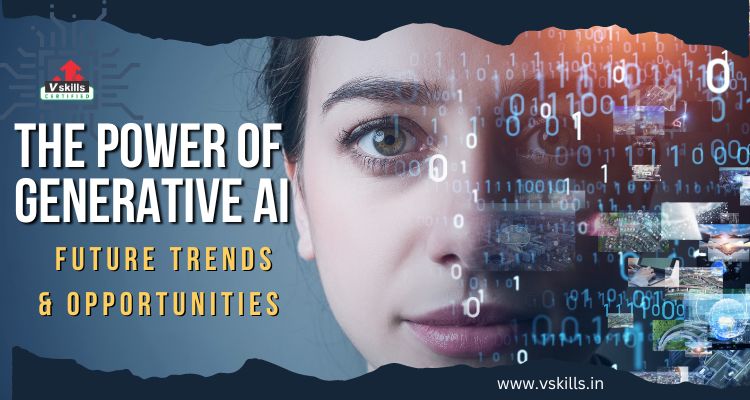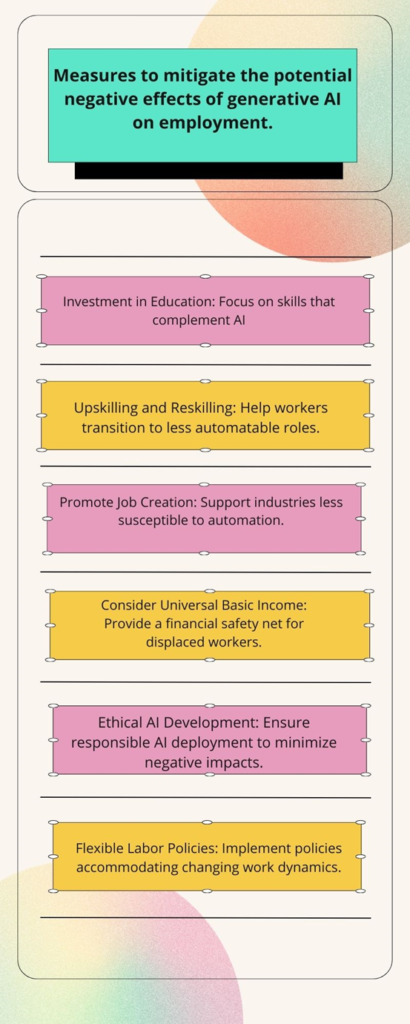Hold onto your imagination, folks! Generative AI is like finding a magic paintbrush that lets you draw things you never even thought of. Suddenly, robots become your artistic partners, dreaming up worlds and solutions you couldn’t imagine on your own. It’s an invitation to explore a parallel universe of creativity, where the only limit is your own mind.
Exploring Generative AI
Imagine AI not just crunching numbers, but creating art, music, and stories! That’s Generative AI, a special kind of AI that can make new things on its own. It learns from tons of data, like pictures and words, and then uses that knowledge to invent brand new stuff. This means machines can be our creative partners, helping us write songs, design buildings, or even write novels! Generative AI is changing the way we work in many fields, from medicine to advertising, and it’s opening up exciting possibilities for the future.
The Intersection of Creativity and Technology
The intersection of creativity and technology is a hotbed of innovation, constantly rewriting the rules of what’s possible. One of the most exciting players in this space is generative AI, a type of artificial intelligence that can create completely new content on its own.
The days have gone by when creativity was solely a human domain. Generative AI leverages powerful algorithms and massive datasets to understand and even generate content like art, music, and stories. This doesn’t spell doom for human artists, but rather creates a collaborative environment where machines learn from us and we learn from them, pushing the boundaries of what each can achieve.
Generative AI’s impact extends far beyond the artistic realm. It’s transforming industries like design, music, storytelling, and even medicine, opening doors to possibilities we never imagined. And as we continue to explore this dynamic intersection, the potential for even more groundbreaking advancements seems limitless.
Redefining Creativity in the Digital Age with Generative AI
In the contemporary digital landscape, the intersection of art and technology is pushing the boundaries of creativity to new heights. Join us on a voyage to delve into the transformative influence of generative AI on redefining creativity in the digital domain.
1. Exploring Generative Art: Bridging Pixels to Paintings
- Observe the birth of generative art, where algorithms breathe vitality into pixels, resulting in captivating visual compositions.
- Investigate the intersection of human intent and machine autonomy, as artists collaborate with generative AI to co-author remarkable artworks.
- Delve into the myriad styles and methodologies of generative art, ranging from abstract forms to hyper-realistic landscapes, each showcasing the distinctive capacities of generative algorithms.
2. Harnessing Generative Design for Future Innovations
- Engage with the transformative potential of generative design, as algorithms propel innovation and refine solutions across diverse sectors.
- Discover the utilization of parametric modeling and optimization techniques by generative design algorithms to craft efficient and sustainable designs.
- Explore practical applications of generative design in domains such as architecture, product design, and urban planning, fundamentally reshaping the conceptualization and creation of physical environments.
3. Interactive Engagement: Immersing in Generative Media
- Submerge yourself in interactive encounters driven by generative AI, where users assume the role of co-creators in the creative journey.
- Uncover how generative algorithms dynamically generate personalized content, adapting to user inputs and preferences in real-time.
- Investigate the merging of generative AI with augmented reality (AR) and virtual reality (VR), blurring the boundaries between digital and physical realms to craft immersive and captivating experiences.
4. Pondering the Future of Creativity: Collaboration and Discovery
- Contemplate the evolving roles of artists and designers amidst the rise of generative AI, where creativity blossoms through collaborative endeavors between humans and machines.
- Reflect on the ethical considerations and hurdles associated with integrating generative AI into artistic and design spheres, encompassing concerns of authorship and algorithmic bias.
- Envision a future where generative AI empowers individuals from diverse backgrounds to unleash their creative prowess, democratizing access to artistic expression and innovation.
As we traverse the dynamic terrain of art and design in the digital epoch, generative AI emerges as a potent force for catalyzing creativity and fostering innovation.
Music Composition: Harmonizing Algorithms with Melody
In harmonizing algorithms with melody, Generative AI empowers composers to venture into uncharted sonic realms and unleash their creative potential in unprecedented ways. Let’s delve into the transformative impact of Generative AI on music composition.
The Harmony of Algorithms
- Generative AI algorithms meticulously analyze extensive musical datasets, discerning patterns and structures to guide the composition process.
- Utilizing machine learning techniques, algorithms assimilate insights from existing music to craft original compositions imbued with human emotion and ingenuity.
- These algorithms adapt and refine their compositions over time, continually honing their craft through feedback and interaction with composers and listeners alike.
Orchestrating Melodic Tapestries
- Generative AI algorithms craft melodies, harmonies, and rhythms that enthrall audiences with their intricacy and allure.
- Composers collaborate with Generative AI to explore novel musical concepts and experiment with unconventional sounds and arrangements.
- • By blending human creativity with algorithmic ingenuity, composers can forge compositions that transcend traditional music genres and conventions.
Charting Unexplored Musical Territories:
- Generative AI paves the way to uncharted musical territories, allowing composers to venture into genres and styles previously beyond reach.
- Composers can leverage generative techniques to craft music that transcends cultural boundaries, reflecting a myriad of influences and perspectives.
- Generative AI fosters collaboration among composers, performers, and technologists, fostering interdisciplinary innovation and creativity.
As we merge algorithms with melody, Generative AI emerges as a catalyst for musical exploration and innovation, reshaping the landscape of music composition in profound ways.
Writing and Storytelling: The Rise of AI Authors
With the advent of Generative AI, machines are emerging as authors, weaving narratives and crafting prose with astonishing creativity and precision. Explore the rise of AI authors and the implications of this groundbreaking development.
The Genesis of AI Authors
- Generative AI algorithms meticulously analyze extensive text corpora, mastering the intricacies of language and narrative composition.
- AI authors produce original stories, articles, and poetry, skillfully emulating the style and voice of human writers with remarkable fidelity.
- These AI-generated creations blur the lines between human and machine creativity, prompting readers to reconsider traditional notions of authorship and artistic expression.
Exploring the Realm of Narrative Potential
- AI authors are unconstrained by the bounds of human imagination, enabling them to traverse diverse genres, themes, and storytelling methods.
- Ranging from science fiction to romance, mystery to poetry, AI-generated narratives span a broad spectrum of genres, captivating audiences with their ingenuity and unpredictability.
- Writers collaborate with AI counterparts to co-author stories, leveraging the algorithm’s capacity to generate innovative ideas and plot twists that inspire and challenge their creative process.
Navigating Challenges and Ethical Dilemmas
- The ascent of AI authors prompts ethical inquiries concerning authenticity, intellectual property rights, and the role of human creativity in the creative continuum.
- Readers grapple with the notion of whether AI-generated narratives can evoke the same emotional resonance and cultural significance as those crafted by human authors.
- Authors and publishers confront the legal and moral complexities surrounding AI-generated content, endeavoring to strike a balance between innovation and integrity within the literary realm.
Envisioning the Future of Writing and Storytelling:
- As AI authors evolve, they herald new prospects for collaboration, experimentation, and innovation in the realm of writing and storytelling.
- Writers and readers alike are encouraged to embrace the diverse array of voices and perspectives that AI authors contribute to the literary landscape, fostering a more enriched and inclusive creative community.
The emergence of AI authors signifies a fresh chapter in the annals of literature, where human and machine creativity intersect to redefine the boundaries of storytelling and the essence of authorship.
Influence of Generative AI on Human Creativity
Exploring the multifaceted influence of generative AI on human creativity unveils transformative effects on the creative process. Let’s delve into these dimensions and consider the ethical considerations they evoke.
Enhancing Creative Capacities
- Generative AI acts as a catalyst, amplifying creativity by equipping artists, writers, musicians, and designers with innovative tools to explore and expand their artistic horizons.
- By generating fresh ideas, patterns, and concepts, generative AI encourages human creators to venture beyond conventional boundaries, fostering experimentation and imaginative leaps.
- Collaborating with generative AI aids in overcoming creative hurdles, revealing unexpected connections, and opening doors to novel forms of expression.
Democratizing Creative Access
- Generative AI democratizes the creative landscape, granting individuals from diverse backgrounds access to tools and resources for artistic expression and innovation.
- Through automation of laborious tasks and streamlining of complex processes, generative AI reduces entry barriers for aspiring creators, enabling them to actualize their creative aspirations more readily.
Redefining Collaborative Dynamics
- Generative AI reshapes collaborative paradigms, blurring distinctions between human and machine creativity, fostering novel modes of partnership and co-creation.
- Human creators engage in collaborative endeavors with generative AI across various domains like music composition, story crafting, and artwork design, leveraging the algorithm’s capabilities to enrich creative output.
Ethical Contemplations
- The widespread adoption of generative AI triggers ethical deliberations surrounding issues of authorship, authenticity, and cultural sensitivity, prompting discourse on attribution, ownership, and responsibility.
- Concerns arise regarding potential biases, manipulations, and misuses inherent in generative AI systems, underscoring the necessity for ethical guidelines, regulatory frameworks, and conscientious practices in creative AI development and utilization.
- As generative AI integrates further into creative workflows and cultural fabric, prioritizing transparency, diversity, and inclusivity becomes imperative to uphold equitable access and representation within creative endeavors.
Addressing concerns about automation and job displacement
Addressing concerns about automation and potential job displacement due to generative AI (Artificial Intelligence) requires a multifaceted approach that combines proactive strategies at both societal and individual levels. Here are few points to consider:
By implementing these measures, societies can better mitigate the potential negative effects of generative AI on employment
Overcoming Limitations: The Quest for More Advanced Generative Models
Generative AI faces challenges such as mode collapse, training instability, and data efficiency. To address these limitations, researchers are exploring advanced techniques:
- Attention Mechanisms: Improving focus on relevant features for higher-quality outputs.
- Self-Supervised Learning: Learning meaningful representations from unlabeled data to enhance generalization.
- Cross-Modal Generation: Generating content across different modalities for multimodal understanding.
- Robustness and Fairness: Developing models to mitigate biases and ensure equitable outputs.
- Quantum-Inspired Approaches: Exploring quantum-inspired algorithms for enhanced efficiency and scalability.
These efforts aim to propel generative AI towards greater sophistication and effectiveness across diverse applications.
The Role of Research and Collaboration in Shaping the Future
Innovation and progress in any field, especially in emergent technologies like AI, heavily rely on robust research efforts and collaborative endeavors. Here’s a succinct overview of their roles:
- Driving Innovation: Research fuels innovation by exploring new ideas, methodologies, and technologies. It drives breakthroughs, pushing the boundaries of what is possible in AI development.
- Knowledge Expansion: Research expands the collective understanding of AI, uncovering new insights, theories, and principles. This knowledge serves as the foundation for further advancements.
- Problem Solving: Researchers tackle complex challenges and address pressing issues within the AI landscape. Their work leads to the development of solutions that drive progress and overcome obstacles.
- Setting Standards and Best Practices: Research contributes to the establishment of standards and best practices within the AI community. This ensures consistency, reliability, and ethical conduct in AI development and deployment.
- Fostering Collaboration: Collaboration among researchers, academics, industry professionals, and policymakers fosters interdisciplinary exchange and cross-pollination of ideas. Collaborative efforts accelerate progress and drive collective innovation.
- Addressing Societal Impact: Research examines the societal implications of AI, including ethical considerations, bias mitigation, and the impact on the workforce. This informed perspective guides responsible AI development and deployment.
- Training the Next Generation: Research institutions play a vital role in educating and training the next generation of AI researchers and practitioners. They cultivate talent, foster critical thinking, and prepare future leaders in the field.
In essence, research and collaboration are indispensable drivers of progress in shaping the future of AI. Their synergistic interplay fuels innovation, expands knowledge, addresses challenges, and ensures that AI development remains ethical, responsible, and beneficial to society.
Real-World instances of Generative AI in Action
Generative AI has embarked on a transformative journey, reshaping industries, inspiring creativity, and pushing the boundaries of innovation. As we reflect on this journey, we anticipate a future brimming with possibilities and opportunities for generative AI.
Reflecting on the Journey: What Lies Ahead for Generative AI
From artistic creations to medical breakthroughs, generative AI has demonstrated its versatility and impact across a myriad of domains. We’ve witnessed the evolution of sophisticated models like GANs and VAEs, unlocking new avenues for content creation, image synthesis, and beyond. Despite challenges like mode collapse and training instability, researchers have persevered, driving advancements that come forward.
Looking ahead, the trajectory of generative AI is promising. With ongoing research efforts focused on overcoming limitations and exploring novel techniques, we anticipate even greater strides in the field. From improved attention mechanisms to quantum-inspired approaches, the quest for more advanced generative models continues, promising enhanced capabilities and applications.
Embracing the Boundless Potential of Human-Machine Collaboration
As we chart the future of generative AI, it’s essential to recognize the power of human-machine collaboration. While AI contributes remarkable capabilities, human creativity, intuition, and expertise remain invaluable. By embracing collaboration, we can harness the complementary strengths of humans and machines, driving innovation and creating solutions that transcend what either can achieve alone.
Generative AI holds the potential to revolutionize industries, inspire new forms of expression, and tackle complex challenges facing society. As we embrace this boundless potential, let us do so with a commitment to ethical AI development, responsible deployment, and equitable outcomes for all. As we venture into the future, let us continue to push the boundaries of innovation, foster collaboration, and unleash the transformative power of generative AI to shape a brighter tomorrow for all.






